Nicknamed the silver cloud plant, Philodendron mamei can sometimes seem more like a silvery vapor mass than a plant.
(No, that’s not quite true.)
But this rainforest native from Ecuador does boast an intriguing growth pattern and stunning silver-patterned leaves, while still being pretty easy to take care of.
If you’re ready to welcome this cloud of joy into your plant family, we’ve got a comprehensive Philodendron mamei care guide that’ll teach you everything from the ideal environment to how to propagate, repot, and deal with the most common issues that come up.
Table of Contents
Philodendron Mamei care
History, Habitat, and Characteristics
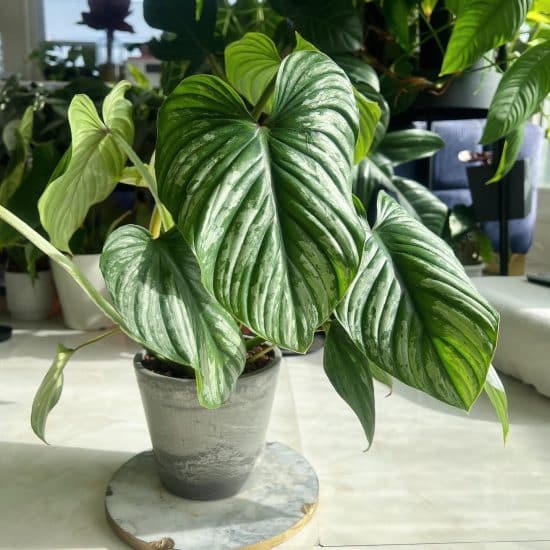
Philodendron mamei, also known as the silver cloud plant or silver leaf philodendron, hails from the lush rainforests of the eastern Andes in Ecuador. It’s an epiphyte (which means it grows on another object or plant for physical support), from the Araceae family.
French horticulturalist and famed landscape architect Édouard-François André first described P. mamei in 1883. What makes it so unique?
The mamei, sometimes called the blotched philodendron or quilted silver leaf plant (yup, more nicknames!), prefers to creep along surfaces, spreading its dark green leaves horizontally as a ground cover. But where did those somewhat odd nicknames come from?
It’s all the fault of those gorgeous heart-shaped leaves. They can get pretty big, boasting stunning silver markings (a bit like the famous Brandtianum plant) that sometimes look smeared or blotched (there’s one nickname origin!).
They’ve also got a bit of pink behind the petioles (which in turn are a bit frilly, like P. plowmanii’s). Veins are etched so deeply into the leaves that they almost look pleated, or quilted (two for two!).
Varieties
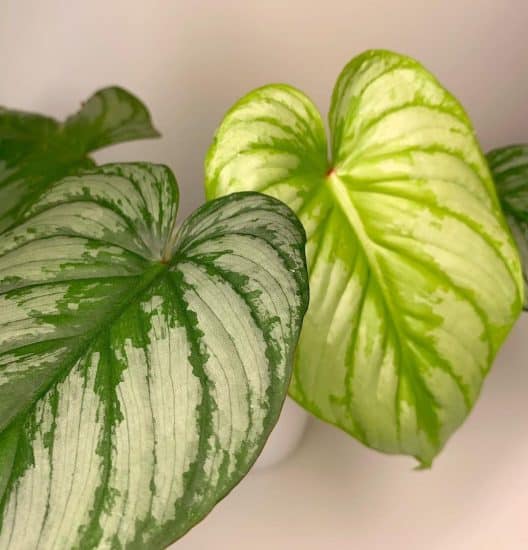
Philodendron mamei or Philodendron ‘Silver Cloud’?
The jury is still out on this one. Some people think ‘Silver Cloud’ has more silver variegation than P. mamei, and we’ve seen comparisons of minor leaf and petiole shape differences.
We’ve also heard people claim ‘Silver Cloud’ is a P. mamei hybrid, while others maintain they’re just closely related. Care is the same for both, though, so don’t worry if you’re not sure which one you’ve got!
Philodendron mamei vs. Philodendron sodiroi?
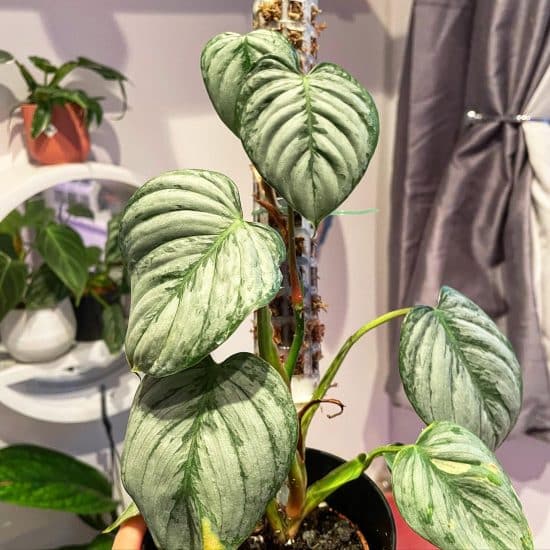
They’re both rare plants in the philodendron genus (shocker, I know), but P. mamei is a creeper, while P. sodiroi is a climber. Their coloring is different as well: P. mamei has dark to medium green petioles, while P. sodiroi has reddish-pinkish ones that are less mottled. They both have lateral veins, but P. mamei’s are closer together.
The takeaway? P. mamei isn’t going to need a moss pole any time soon.
Now you can tell the difference between look-alike tropical plants, but do you know how to keep the silver cloud plant on cloud nine? Philodendron mamei care, coming right up.
Light
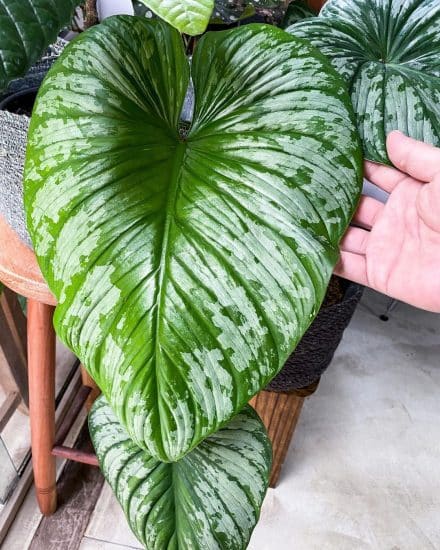
Let’s delve into how to create the perfect lighting conditions for the Philodendron mamei.
First things first: where does this tropical beauty naturally thrive? Philodendron mamei grows under the forest canopy in its natural habitat, so it loves basking in bright, indirect light. It can take a little bit of direct sunlight, but not much.
Morning light (through an east or north-facing window, perhaps) really hits the spot for this plant, which makes sense — who wouldn’t love waking up with a bit of sunshine?
Now, you might be asking yourself, “How can I tell if my Philodendron mamei is getting the right amount of light?” Great question! Observing your plant’s behavior is key to understanding its needs.
Are the leaves looking dull and the growth uneven? Uh-oh, seems like your silver cloud plant might not be getting enough light. In this case, try moving it closer to a window or introducing a grow light (LED and full spectrum would be the way to go).
On the flip side, too much direct light can cause some issues, too. If you see yellow, sun-bleached leaves or small holes developing, it’s time to take action. Consider moving your Philodendron mamei a little further from the window or using a sheer curtain to filter that harsh sunlight.
Water
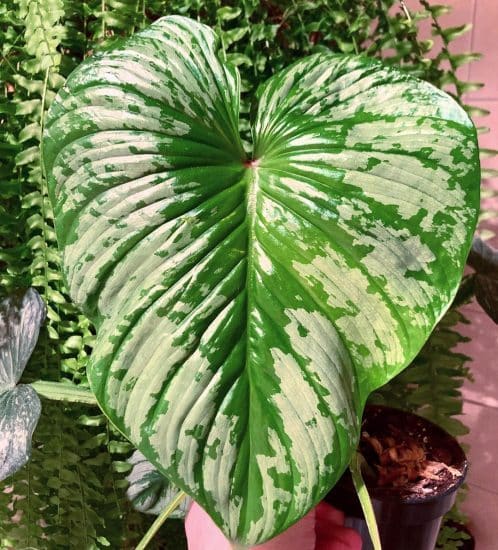
How to keep this the Philodendron mamei well-watered and thriving? It’s actually pretty simple once you get the hang of it!
First off, wait until the soil is completely dry before watering your Philodendron mamei plant. We’re talking bone dry here. This is super important because overwatering can cause those gorgeous lower leaves to turn yellow and possibly cause root rot . . . and nobody wants that, right?
Now, how do you know when it’s time to water? Just stick your finger an inch or two into the soil. If it feels dry and loose, go ahead and give your plant a drink. But if you feel moist soil, hold up! Give it some more time to dry out.
When you do water your Philodendron mamei, give the soil a good soak. Make sure the water drains out through the pot’s holes, and don’t forget to dump any excess water that may be lingering in the saucer. Standing water is a big no-no for this plant.
So, what does too little water look like? You’ll see the oldest leaves (usually the ones at the bottom) turning bright yellow. If that’s happening, it’s a sign to up your watering game! And don’t forget to pluck off those sad, dying leaves, because you don’t want them attracting any pesky Philodendron mamei pests like fungus gnats. And if your plant’s leaves are curling up, that’s another clue it needs more water.
But what about too much water? Yeah, that can be a problem too. You might notice yellowing leaves, mushy stems, or soil that just won’t dry out. If you see brown leaf tips and small brown or black spots on the leaves, your plant could be dealing with root rot. In that case, see our section on “Pests and diseases” below.
Spotting brown or yellow leaves? It might be the water. If you’ve been using tap water, notice this problem, and can’t pinpoint another cause, try switching to distilled, filtered, or rainwater if you can. This will prevent chemical buildup in the soil, which turns those edges unhealthy, unsightly colors.
Temperature and Humidity
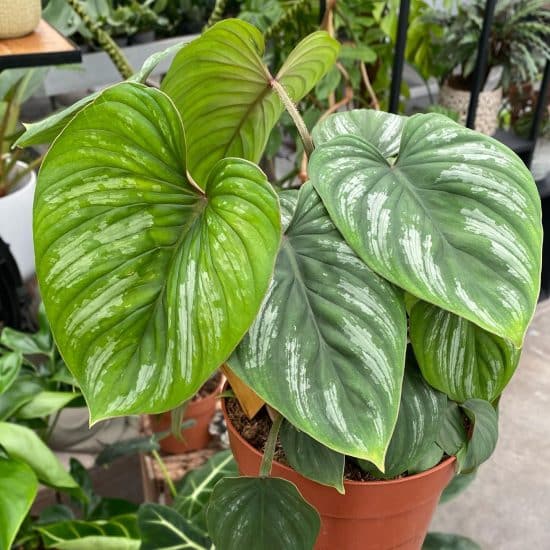
If you want to grow Philodendron mamei indoors, you’ve got to understand its ideal temperature and humidity conditions.
This plant thrives in temperatures ranging from 65 to 85°F — in other words, normal room temperature. Outdoor growers should take care to ensure the temperature doesn’t drop below 60°F, as these plants don’t take kindly to the cold.
Too much exposure to cold temperatures or sudden temperature changes can cause the plant to lose leaves. This can even happen during the transit home from the store, so make sure to keep it warm from the start (wrap it in a light blanket or towel, or ask the store owners to pack it up for you).
Humidity is another important factor for Philodendron mamei’s well-being. As a tropical plant, it enjoys a good amount of humidity — think at least 50%, and preferably 60%.
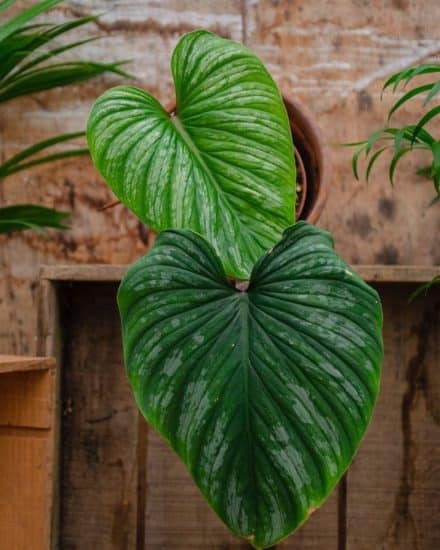
However, there are a few signs to watch for that might indicate it’s getting too much or too little humidity. If you notice the leaves turning yellow, curling, or developing brown tips, it’s likely your plant isn’t receiving enough humidity. On the other hand, if you see mold or fungus developing, it might be a sign there’s too much humidity.
To strike the right balance and keep your Philodendron mamei happy, consider placing it near a humidifier or on a tray of water and pebbles to raise the humidity levels in its immediate environment.
Misting doesn’t really help to raise humidity long-term, but it does work to clean off dust and deter pests. If you do, be sure to wipe the leaves with a cloth afterward to remove any excess moisture.
Temperature and humidity care tips for Philodendron mamei:
- Aim for room temperatures between 65-85°F, avoiding sudden changes or exposure to cold conditions.
- Opt for humidity levels around 60% to replicate the plant’s tropical habitat.
- Use a humidifier or pebble tray to raise the humidity around your plant.
- Take extra care to keep your plant warm and comfortable during transit or when moving to a new location.
Soil and Planting
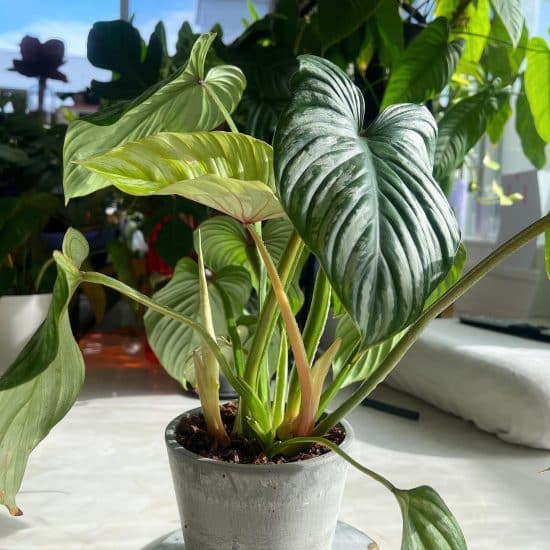
Philodendron mamei thrives in a well-draining, moisture-retaining potting mix. That might seem like a contradiction, but it’s all about finding that balance.
The ideal mix for Philodendron mamei is a blend of high-quality potting soil, coco coir or peat moss, and perlite. You can also add garden compost to enrich the mix.
Aim for a mix of:
- 50% potting soil
- 30% coco coir or peat moss
- 20% perlite
Achieving the right balance between draining and retaining water is really important to prevent rotting roots or nutrient deficiencies. If you notice that your Philodendron mamei’s leaves are turning yellow or wilting, this could mean you need to tweak your soil mix so it gets more air to the roots and drains more smoothly.
Repotting
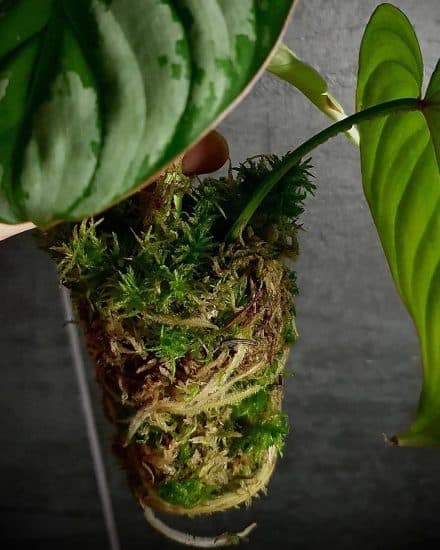
Philodendron mamei is a moderately fast-growing plant, and repotting every 2-3 years will ensure healthy growth. Spring is the best time to repot, since the plant is actively growing and less likely to be stressed then.
Choose a pot no more than 2 inches larger in diameter than the current one, and make sure it has adequate drainage holes so the soil doesn’t get waterlogged. Carefully transfer the root ball to the new pot, then lightly press down the potting mix. Avoid packing the soil too tightly, as this can inhibit oxygen flow to the roots and potentially cause root rot.
Fertilizing
Fertilize your Philodendron mamei regularly during the growing season (spring and summer). Use a balanced liquid houseplant fertilizer diluted to half-strength every month. Don’t fertilize in winter when your plant is dormant, since it doesn’t need the nutrients then and won’t be able to take them up anyway. In fact, this could even hurt your mamei!
If you’re over-fertilizing, you’ll see burnt leaf tips, yellowing leaves, or stunted growth. If you think this is the issue, flush the soil with water to help remove excess fertilizer. Follow the instructions on the bottle when you fertilize again, which will probably mean reducing the amount and frequency.
Propagation
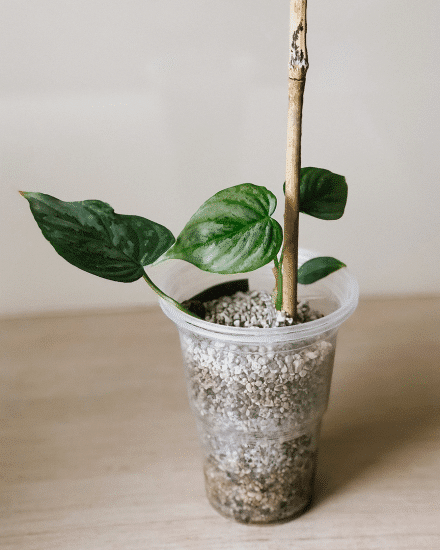
Philodendron mamei propagation via stem cuttings is the most popular route. It’s also the easiest. (That can’t be a coincidence, can it?). This plant does have aerial roots, so you can propagate it by air layering too, if you’d like, but we’ll cover the stem cuttings method here.
Propagating Philodendron mamei by stem cutting:
- First things first, snip single-node cuttings from your Philodendron mamei mother plant. Remember, each cutting should have some roots and a growing eye (a small bump that may be hard to spot).
- Rub some activated charcoal on the cut ends to stave off infection and rot.
- Choose the best propagation medium for your cuttings depending on the size of their roots. a) Got cuttings with teeny-tiny roots? No worries, just propagate them in water by placing your cutting in a container filled with filtered water, and give it a little refresh every few days. Don’t forget some bright, indirect sunlight to help it flourish!
b) Rocking medium-sized roots? Let’s introduce them to sphagnum moss. The moss is like a big cozy bed, retaining moisture and encouraging root growth. Keep it damp but not drenched. If you can see the eye, make sure to keep it facing up so it grows in the right direction.
c) Lucky enough to have cuttings with long roots? Time to plunge them straight into potting mix! If you can see the eye, make sure to keep it facing up. Keep the soil consistently moist during the early growing days, and remember, bright indirect light is the key to success. - Be patient and let your cuttings hang out in their potting medium. When you see new leaves sprouting, it’s the perfect time to transplant them to their new homes, whether that be from water or sphagnum moss to soil, or just to a larger pot.
And that’s all it takes!
Some handy Philodendron mamei propagation tips:
- Always use sterilized tools when taking cuttings. It’s like a plant surgery — gotta keep it clean and infection-free!
- Propagate during spring and summer to give your budding newbies the best chance to thrive.
All done? Enjoy your new silver cloud plants — we knew you could do it all along!
Common Issues
Like all indoor plants, Philodendron mamei can run into a few hiccups along the way. Let’s get into some of the most common issues you might find with this plant and how to fix them. It’ll be back to thriving in no time!
Yellow Leaves
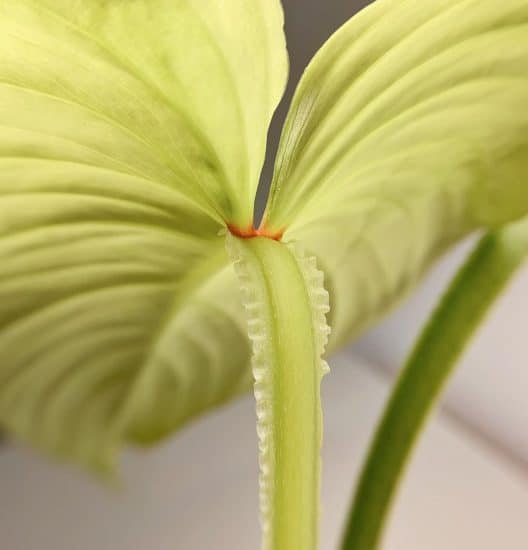
You might notice the lower leaves turning yellow. Oops! That’s usually a sign of overwatering. But hey, it happens to the best of us. Here’s what you need to do: let the top two inches of soil dry out before watering again. This way, you’ll avoid drowning your plant while still keeping it hydrated.
And don’t forget to make sure it’s getting enough indirect bright light, too. Leaves can turn yellow if they’re not getting enough light to photosynthesize properly.
If just the leaf edges are yellow and you’re using tap water, try switching to filtered water to prevent any unwanted chemical buildup in the soil. Your Philodendron mamei will thank you!
Brown Leaf Tips
Now, brown leaf tips can be a bit trickier. There could be a few reasons why this is happening, including low humidity, underwatering, or even a buildup of salts and minerals from over-fertilizing. Let’s break it down step by step.
First, check the humidity around your plant. If it’s not high enough, place a tray of water with pebbles nearby or use a humidifier. If humidity’s not the problem, it could be underwatering — and that’s an easy fix! Only water when the soil is dry one or two inches down.
Lastly, those pesky brown leaf tips might be due to over-fertilization. In that case, flush the soil with water and cut back on the fertilizer amount or frequency. Your mamei’s leaf tips should green up in no time!
Pests and Diseases
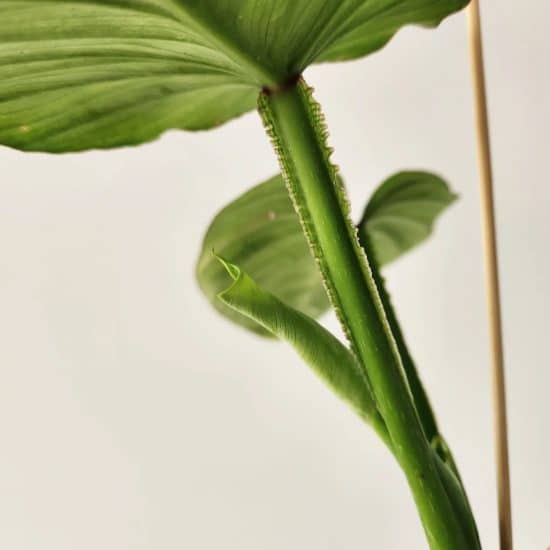
Philodendron mamei plants are relatively low-maintenance and don’t attract as many pests as other houseplants. But hey, no plant is perfect, right?
Let’s cover some diseases and pests that might give your Philodendron mamei a hard time . . . and more importantly, how to fix those issues!
Pests
All right, first up are those pesky bugs. While the Philodendron mamei isn’t a bug magnet, it can still get bothered by the usual suspects: mealybugs, aphids, scale insects, and spider mites. What do they look like?
- Mealybugs: These little troublemakers look like tiny white cotton balls on your plant’s leaves and stems.
- Aphids: You’ll usually find these small, green critters hanging out on new growth (they just love it!).
- Scale insects: They appear as small brown or white bumps on your mamei plant’s stems and leaves. Talk about camouflage!
- Spider mites: These are particularly sneaky — you might not see them, but you may notice tiny webs on the underside of the leaves.
Solution: First things first, isolate your plant to keep the bugs from throwing a party with your other plants. Now gently remove any visible pests using a damp cloth or cotton swab.
For tougher infestations, break out the insecticidal soap or neem oil (just follow the instructions on the label). Keep an eye on your plant for any signs of pests so you can tackle any future issues ASAP.
Root Rot
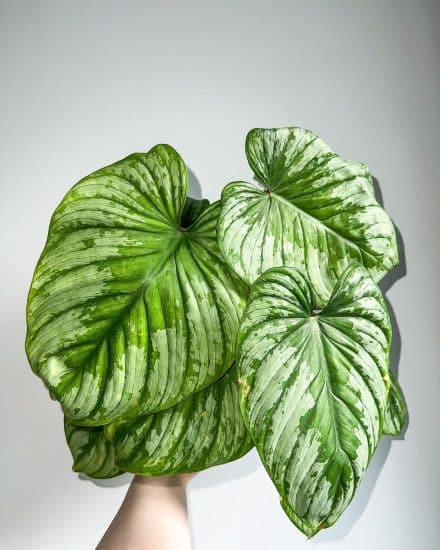
Yup, even the Philodendron mamei can fall victim to this soggy issue. It happens when the plant’s roots get too much moisture and start rotting away.
You might have root rot if you notice yellowing or wilting leaves, a foul smell, and black or brown, mushy roots. To check, gently remove your plant from its pot and take a look at the root situation.
Solution: Don’t panic (and remember to breathe)! Here’s what to do. Grab some sterilized scissors (use boiling water or alcohol) and trim away those nasty, affected roots. Remember to sterilize the implements afterward too!
Then repot your Philodendron mamei in fresh potting soil, well-draining soil. Add some perlite, pumice, or even LECA to level up the aeration and drainage game.
To prevent rot in the future, check that your pot has proper drainage holes (super important) and avoid letting your plant sit in standing water. As always, water your plant with care, and let the top few inches of soil dry out between drinks.
Conclusion
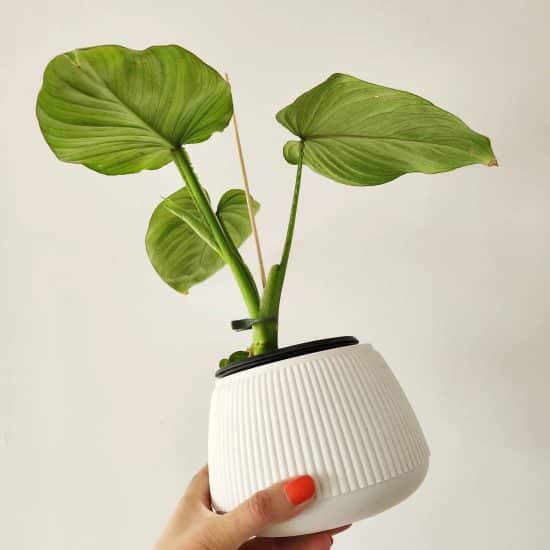
That’s it for our Philodendron mamei care guide! You should be well-equipped to handle any challenges that come your way, ensuring your gorgeous Philodendron mamei stays happy and healthy.
Philodendron mamei care summary:
- Choose a well-draining soil mix made up of regular potting soil, peat moss, and perlite for the perfect balance of moisture retention and drainage.
- This beauty enjoys bright, indirect light, and just a little bit of direct light (too much direct sun may scorch its silvery leaves). Keep an eye on the lighting conditions, and adjust as needed for a happy plant.
- Allow the top few inches of soil to dry out before watering your plant again. Keep an eye out for signs of over- or underwatering, such as yellowing leaves or wilting.
- Provide your Philodendron mamei with ideal temperature and humidity levels, aiming for 65-85°F and around 60% humidity.
- Fertilize monthly during the growing season with a balanced, liquid houseplant fertilizer diluted to half-strength.
We really hope this care guide has helped you on your journey with your beautiful Philodendron mamei. If you have any questions, don’t hesitate to reach out to us. And if you found this guide useful, share it with fellow P. mamei parents!
Take care, and happy growing!
FAQ
Is Philodendron mamei a fast grower?
That would be a yes. The Philodendron mamei is a moderately fast-growing plant that loves to stretch its leaves out in your space. So, if you provide it with the right conditions — think bright indirect light, well-draining soil, and high humidity — you’ll witness its lush green foliage expanding at a pretty swift pace.
Is Philodendron mamei rare?
Philodendron mamei is a comparatively rare plant. While it’s not the most difficult plant to find in specialty plant shops or online, it’s definitely not as common as some other philodendron varieties. With its striking silvery patterns, it’s safe to say P. mamei is considered a rare gem among houseplants.
Is Philodendron mamei toxic?
Yes, this plant is toxic to pets and humans. It contains calcium oxalate crystals, which can cause irritation and discomfort if ingested. So, make sure to place your Philodendron mamei out of reach of curious pets and little ones to prevent any accidental nibbles.
Is Philodendron mamei and silver cloud the same?
This is a tricky one. Philodendron mamei goes by the charming nickname “silver cloud” because of its silvery patterns. But some people maintain that Philodendron mamei and Philodendron ‘Silver Cloud’ are different plants. Either way, care is the same for both!
Does a Philodendron mamei crawl or climb?
Unlike its near look-alike, the P. sodiroi, Philodendron mamei is a crawler through and through.


